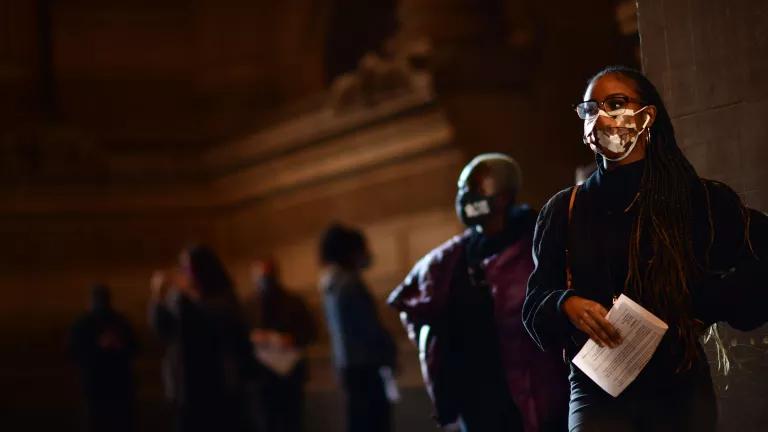How to Cast Your Ballot Safely on Election Day
If you’re voting in person, go prepared, take the usual COVID-19 precautions—and have patience.

Voters wait in line outside Philadelphia City Hall to cast their early voting ballots, October 27, 2020.
The COVID-19 pandemic has caused a significant shift in how Americans vote, with a record number of voters casting their ballot by mail or early in-person in order to stay safe. In fact, just 27 percent of voters voted in person on Election Day in 2020. Record turnout is expected again for this year’s midterm elections. So, if you’re planning to head to the polls to vote in person—whether early or on the big day—make sure to take basic preventative measures to protect yourself and your community. Here’s how.
Confirm your registration and polling location.
First thing’s first: Check your registration status and find your polling place. If you haven’t registered, some states offer same-day registration and will allow you to register and vote at the same time. If you hope to avoid the crowds, see if your state offers early voting or mail-in voting. (We have guides on how to do both.)
Wear a mask and come prepared.
If you decide to vote in person, take the same precautions you would take in any public setting during the pandemic: Wear a mask or face covering, wash your hands with soap and water before and after going to your polling place, and bring hand sanitizer.
The CDC also recommends bringing your own supplies to help prevent delays at your election site and limit your time at the polls. Remember to pack a black-ink pen; any required documentation, such as your identification (check with your voting site if ID is required); and prepared items, such as registration forms (if you’re registering to vote and your state allows same-day registration), voter guides, and sample ballots.
Protect yourself and others from COVID-19 at your polling site.
To avoid waiting in lines with large groups of people, consider voting at off-peak times, such as mid-morning or early afternoon, or voting ahead of Election Day. Regardless of whether there’s a crowd, don’t forget to practice social distancing and stay six feet away from election workers and other voters.
In addition, avoid touching things unrelated to voting, and don’t try to wipe down or disinfect voting machines on your own. Voting machines can be sensitive, and election workers are trained to sanitize the equipment.
Support your community.
If you have flexibility in your schedule, lend others some assistance—while taking precautionary measures, of course. Check in with your neighbors. Do they need a ride to the polls? Does a friend need help arranging childcare?
You have a right to vote, and if you see that someone is preventing you or others from exercising that right, report it by calling 1-866-OUR-VOTE.
Be patient.
With possible precautions and changes in place at your polling site, there may still be long lines. Don’t be discouraged. Make sure to have water, snacks, and reading material with you.
After voting, be patient on election night. Many states will not have complete results in the wee hours of the morning. With more Americans mailing in their ballots, counting the returns will simply take more time.
This NRDC.org story is available for online republication by news media outlets or nonprofits under these conditions: The writer(s) must be credited with a byline; you must note prominently that the story was originally published by NRDC.org and link to the original; the story cannot be edited (beyond simple things such as grammar); you can’t resell the story in any form or grant republishing rights to other outlets; you can’t republish our material wholesale or automatically—you need to select stories individually; you can’t republish the photos or graphics on our site without specific permission; you should drop us a note to let us know when you’ve used one of our stories.

How to Make an Effective Public Comment
A Longtime Advocate for DEI on Making People Feel Welcome
How to Lobby Your Legislator